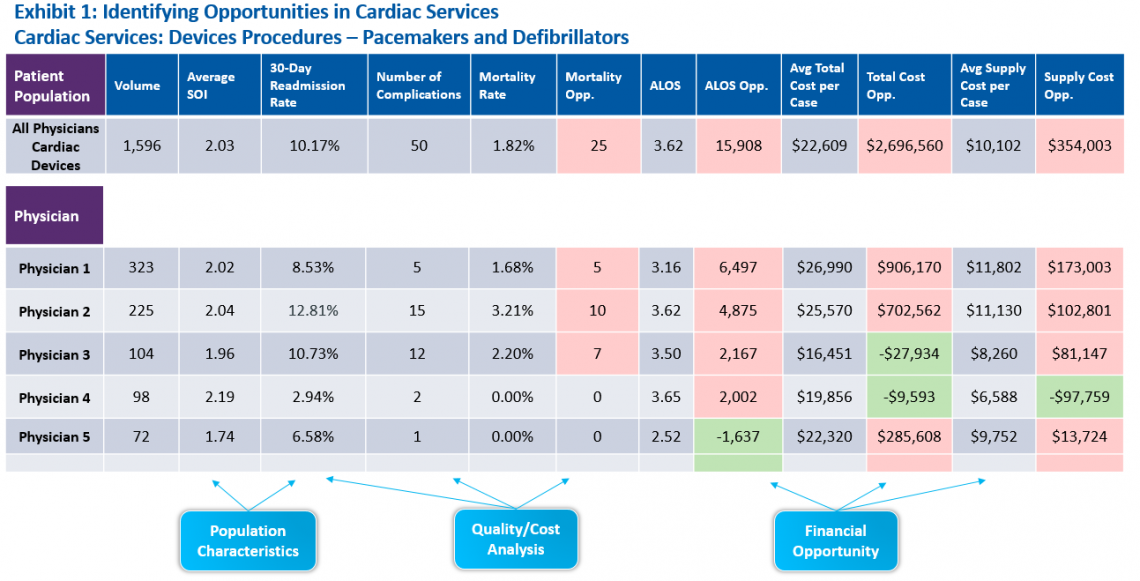The challenges faced by hospitals and health systems on multiple fronts are significant and well documented. The business environment is exceedingly demanding for management teams as they reposition their organizations for strategic growth, competitive differentiation, and sustained financial health.
Hospitals and health systems must excel across multiple dimensions, including financial performance, clinical performance, talent management, and operational efficiency, while making decisions on the strategies and product lines that will best serve consumers in an increasingly competitive environment. The set of initiatives underway in most organizations has increased, but questions persist.
*Are we focused on the right things within and across dimensions?
*Are we achieving the results we expect?
*Are these results ambitious enough now and going forward?
To address these issues and questions, data flow in from claims systems, electronic health records, cost accounting systems, satisfaction surveys, wearable devices, patient portals, pharmacy refill systems, and many more sources. But data alone do not bring clarity. Analytics are required to find the signals in the noise of ever-increasing data loads, producing a “return” on analytics.
At the most basic level, the purpose of analytics is to get the right information to the right people to help them make the right decisions based on their ability to:
- Identify opportunities across the many dimensions in which the organization must excel
- Prioritize opportunities based on the size of the opportunity, importance to the organization, and required effort and resources to pursue the opportunity
- Realize opportunities by providing information that helps monitor and manage the initiatives that have been put in place to secure the returns that the opportunity represents
The ability to identify, prioritize, and realize opportunities ultimately generates the return on analytics. A healthcare organization’s ability to sustain high-value care delivery and ensure its long-term strategic financial viability is increasingly dependent on how effectively it can apply data analytics to inform improvement efforts related to quality, cost, and patient experience.
Following a full definition of the return-on-analytics concept, presented here are a framework for unlocking the value of data, and elements of an effective solution to optimize return on analytics in order to move from strategic opportunity to successful execution across performance dimensions.
“Return on Analytics” Defined
The opportunities available in the multiple dimensions in which hospitals and health systems must excel broaden the concept of “returns” that executives must seek. Quantifiable cost savings remain an essential form of financial return, but equally essential are returns defined by improvements in other core performance areas, including quality, outcomes, patient satisfaction, physician or employee satisfaction, and others.
Returns in these areas create value by improving patient care, avoiding payment penalties, attracting top-notch staff and reducing staff turnover, and other improvements that grow the organization’s business. In many instances, these returns also will have a positive impact on financial health that can be quantified. And to the extent an effective analytics program helps health systems prioritize opportunities, it also can net returns through elimination of the energy and resources expended in pursuing initiatives that are not critical to the organization’s success.
Learn more about Axiom Clinical Analytics
Unlocking the Value of Data
Data has intrinsic value, but requires a framework that will facilitate understanding the data. Health systems have invested heavily in the infrastructure of data—systems that collect and report data—but many organizations need a robust analytics solution that provides a comprehensive comparative framework and a performance-management solution that enables leaders to effectively and efficiently manage performance across multiple dimensions.
A recent survey of senior finance executives quantifies this imperative nationwide.1 A strong majority of respondents (94 percent) are experiencing increasing pressure to have greater insight into how financial results impact business strategy.
94% are experiencing increasing pressure for greater insight
An even greater number (96 percent) think their organizations should be doing more to leverage financial and operational data to inform strategic decisions. In another survey, senior healthcare executives cited a lack of good data and insights into costs and savings opportunities as the top impediment to their organization’s cost transformation efforts.2
96% think they should rely more on data to inform strategic decisions
Analytics can be narrow, limited only to the data generated within an organization, or they can be broadened through the integration of data from sources outside the organization—for example, peer organizations and market data—which bring comparative capabilities and richer context to an analytics program.
Identifying and prioritizing opportunities.
Exhibit 1 provides a starting point for understanding the value that comparative analytics can offer in identifying and prioritizing opportunities, for example, with cardiac-device use in an organization’s cardiac services department.
By compiling internal data on patient characteristics and outcomes across the cardiologists who practice at a particular facility, the organization could construct benchmarks defined, for example, by the outcomes of its top-performing cardiologists or by an average of outcomes across the group. These benchmarks, in turn, would identify the opportunities available if all the cardiologists associated with the facility performed to the benchmarks. Data on individual physicians would identify those for whom performance improvement should be a focus, and in what areas (e.g., length of stay, readmission rates, supply costs) the most attention would be needed.
The top row identifies performance measures of value for the department, including: population/patient characteristics (e.g., severity of illness—SOI); quality metrics with cost/penalty impact (e.g., complications, 30-day readmission rate); and cost metrics (e.g., average cost per case, average supply cost per case). The first gray row identifies the performance of department physicians as a whole across their nearly 1,600 cardiac device procedures.
The bottom portion of the table shows data and opportunities for the top five physicians in the department, as defined by volume of cases. The red boxes indicate where performance improvement could yield improvement opportunities with specific related dollars if the physicians performed at the best-practice level; the green boxes indicate where performance is better than average, thereby indicating an opportunity for improvement through use of a practice used by the best-performing physician.
Through use of this analytic tool, the organization’s leaders identified almost $2.7 million of cost-reduction opportunities, $354K of which could come from supply cost savings, and opportunities to reduce mortality and complications to zero or one. If the organization implemented a performance improvement initiative on the basis of this information alone, it certainly could realize some return on its analytics as measured by improvements in both quality and cost.
Through use of this analytic tool, the organization’s leaders identified almost $2.7 million of cost-reduction opportunities
Unanswered, however, would be a number of questions that could change the organization’s understanding of both the scope of the opportunity and the value of pursuing it. Opportunities and related questions include:
- The opportunities available for this service line compared to those in other service lines. What if an analysis of opportunities for total joint replacements identified even greater opportunities? Depending on the resources available, the organization may prioritize the total joint replacement opportunities.
- The department’s performance relative to other cardiology groups/departments. What if the outcomes for top-performing physicians in this group still lag behind outcomes for other cardiologists at other facilities within the system, or at other peer organizations? If so, the potential opportunities for improvement could be significantly greater. On the other hand, if the lower-performing physicians in this group still outperform other cardiologists, the effort and resources needed to match performance of others to the top-performing physicians in this group might be greater than realized.
- The prospect for future market growth of the selected service. If an analysis of market trend data indicated the likelihood of increasing demand for the selected service, the organization may want to prioritize an improvement initiative within the service area.
With each analysis, the organization’s decision makers gain important new information that helps identify:
- The size of the potential opportunity. If an entity (i.e., group, department, organization) as a whole is underperforming compared to benchmarks derived from peer organizations, the size of the opportunity for clinical and financial gains may be significantly greater than originally realized.
- The importance of the opportunity. If the analysis indicates the prospect for strong financial and clinical performance across the service line and growth within key demographics of the market served, a focus on performance improvement within a selected service may contribute significantly to system revenues and business growth.
- The effort required to realize the opportunity. If the analysis indicates, for example, that most of the clinicians significantly outperform clinicians at other organizations, the effort to further optimize the selected service may require a significant commitment of resources, and may be difficult to achieve. Comparative analytics can provide a grounding in reality that helps an organization set challenging but achievable improvement goals.
With an understanding of the size, importance, and effort required to realize an opportunity, the organization can compare, prioritize, and decide upon organizational pursuits.


